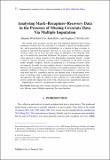Files in this item
Analysing mark-recapture-recovery data in the presence of missing covariate data via multiple imputation
Item metadata
| dc.contributor.author | Worthington, Hannah | |
| dc.contributor.author | King, Ruth | |
| dc.contributor.author | Buckland, Stephen Terrence | |
| dc.date.accessioned | 2014-12-17T15:01:03Z | |
| dc.date.available | 2014-12-17T15:01:03Z | |
| dc.date.issued | 2015-03 | |
| dc.identifier | 467969 | |
| dc.identifier | 5b15ca7d-1650-4888-9926-fd82c240441e | |
| dc.identifier | 84939956407 | |
| dc.identifier | 000352698600002 | |
| dc.identifier.citation | Worthington , H , King , R & Buckland , S T 2015 , ' Analysing mark-recapture-recovery data in the presence of missing covariate data via multiple imputation ' , Journal of Agricultural, Biological and Environmental Statistics , vol. 20 , no. 1 , pp. 28-46 . https://doi.org/10.1007/s13253-014-0184-z | en |
| dc.identifier.issn | 1085-7117 | |
| dc.identifier.other | standrews_research_output: 32042 | |
| dc.identifier.other | ORCID: /0000-0001-5452-3032/work/40183760 | |
| dc.identifier.other | ORCID: /0000-0002-9939-709X/work/73701073 | |
| dc.identifier.uri | https://hdl.handle.net/10023/5932 | |
| dc.description.abstract | We consider mark–recapture–recovery data with additional individual time-varying continuous covariate data. For such data it is common to specify the model parameters, and in particular the survival probabilities, as a function of these covariates to incorporate individual heterogeneity. However, an issue arises in relation to missing covariate values, for (at least) the times when an individual is not observed, leading to an analytically intractable likelihood. We propose a two-step multiple imputation approach to obtain estimates of the demographic parameters. Firstly, a model is fitted to only the observed covariate values. Conditional on the fitted covariate model, multiple “complete” datasets are generated (i.e. all missing covariate values are imputed). Secondly, for each complete dataset, a closed form complete data likelihood can be maximised to obtain estimates of the model parameters which are subsequently combined to obtain an overall estimate of the parameters. Associated standard errors and 95 % confidence intervals are obtained using a non-parametric bootstrap. A simulation study is undertaken to assess the performance of the proposed two-step approach. We apply the method to data collected on a well-studied population of Soay sheep and compare the results with a Bayesian data augmentation approach. Supplementary materials accompanying this paper appear on-line. | |
| dc.format.extent | 496158 | |
| dc.language.iso | eng | |
| dc.relation.ispartof | Journal of Agricultural, Biological and Environmental Statistics | en |
| dc.subject | Individual time-varying | en |
| dc.subject | Continuous covariates | en |
| dc.subject | Mark-recapture-recovery data | en |
| dc.subject | Missing values | en |
| dc.subject | Multiple imputation | en |
| dc.subject | Two-step algorithm | en |
| dc.subject | QA Mathematics | en |
| dc.subject | NDAS | en |
| dc.subject | BDC | en |
| dc.subject.lcc | QA | en |
| dc.title | Analysing mark-recapture-recovery data in the presence of missing covariate data via multiple imputation | en |
| dc.type | Journal article | en |
| dc.contributor.sponsor | EPSRC | en |
| dc.contributor.institution | University of St Andrews. Statistics | en |
| dc.contributor.institution | University of St Andrews. Centre for Research into Ecological & Environmental Modelling | en |
| dc.contributor.institution | University of St Andrews. School of Mathematics and Statistics | en |
| dc.contributor.institution | University of St Andrews. Scottish Oceans Institute | en |
| dc.contributor.institution | University of St Andrews. Marine Alliance for Science & Technology Scotland | en |
| dc.identifier.doi | https://doi.org/10.1007/s13253-014-0184-z | |
| dc.description.status | Peer reviewed | en |
| dc.identifier.grantnumber | EP/I000917/1 | en |
This item appears in the following Collection(s)
Items in the St Andrews Research Repository are protected by copyright, with all rights reserved, unless otherwise indicated.

